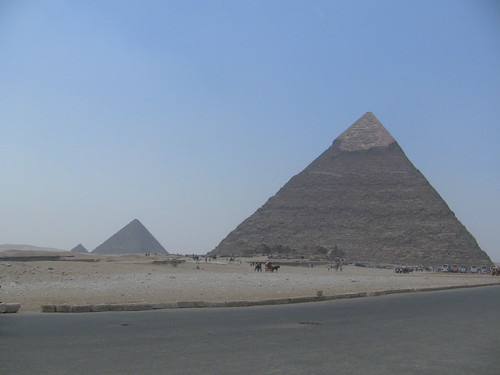Cairo
After 2 full days at sea, the Egyptian port of Alexandria was our first stop. Cairo and the great pyramids of Giza were a 2.5 hour drive each away. Lining up and organizing probably took another 2 hours. All that, and we spent less than 30 minutes at the feet of the pyramids. I would've liked to have spent more time there, but it was enough, and it was worth the trouble. For 5 weeks I've been looking at the intricate details of large structures made hundreds and hundreds of years ago. The pyramids of Giza are something else. Not much detail at all. I didn't see any hieroglyphics or paintings. No mummies. No treasures. Just a simple shape sitting in the sand that has lasted for thousands of years.
I heard a comedian joke about how stupid sharks are. They're so stupid that they swim just high enough to the surface showing their fin, losing the element of surprise. That's basically what I think about rich Egyptian pharaohs and their pyramids holding all their wealth that they thought they could take with them to the afterlife. There are actually hundreds of pyramids in Egypt, and most of them were empty when they were discovered, robbed of their treasures. After a few hundred years, they finally figured out that making giant flashing neon signs pointing to their treasures wasn't such a good idea, so they quit making pyramids. If there was space travel back then, Egypt might have looked like a map with little triangles all over it marking where all its treasures were.
There was a story our guide in Alexandria told us that I really liked and will probably butcher here. There was a pharaoh named Amenhotep III. He loved his wife very much. He even gave her an unusually large amount of power for the wife of a pharaoh. Before this time, statues depicted women at a height no taller than a man's knee. Statues we saw at the museum had both of them at equal height. This pharaoh was one of the first to promote equality between men and women.
They had a son, Akhenaten. He had a very controversial view of religion: he wanted people to worship only a single god. He married a woman with unsurpassed beauty. Her name was Nefertiti. She also had a lot of power for a woman. After their death, people didn't really buy into their religious beliefs and they returned to their old custom of multiple gods.
They had a son named Tutankhamun. For being a pharaoh, he was actually pretty insignificant for his time. He was so insignificant that tomb robbers didn't even bother raiding his tomb. Because of that, King Tut's pyramid was discovered with all its treasures inside including the gorgeous gold mask that you see in every middle school ancient history book. We saw it in the Cairo museum. It made me wonder what all the gold treasures that was stolen from tombs were melted down and made into. This is all thanks to King Tut. The way our guide put it, he is famous because he wasn't famous.
We also got to see the Sphinx, which isn't exactly within walking distance to the pyramids. One of the guides gave a very good theory about why sphinxes are always missing noses. Ancient Egyptians believed that spirits would re-enter the body of sculptures through the noses and eyes. So their enemies destroyed the noses and eyes so that they spirit would never come back to life.


